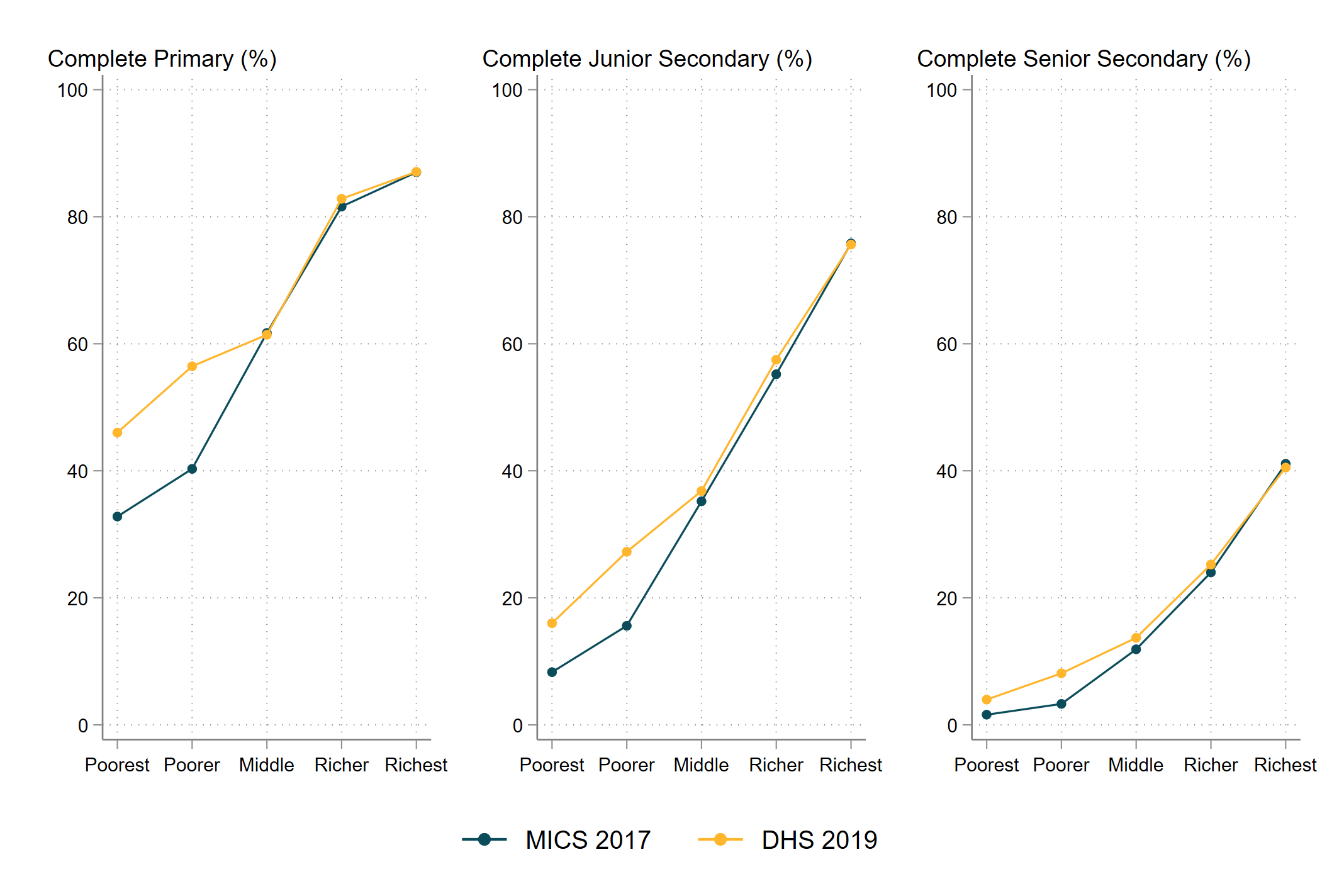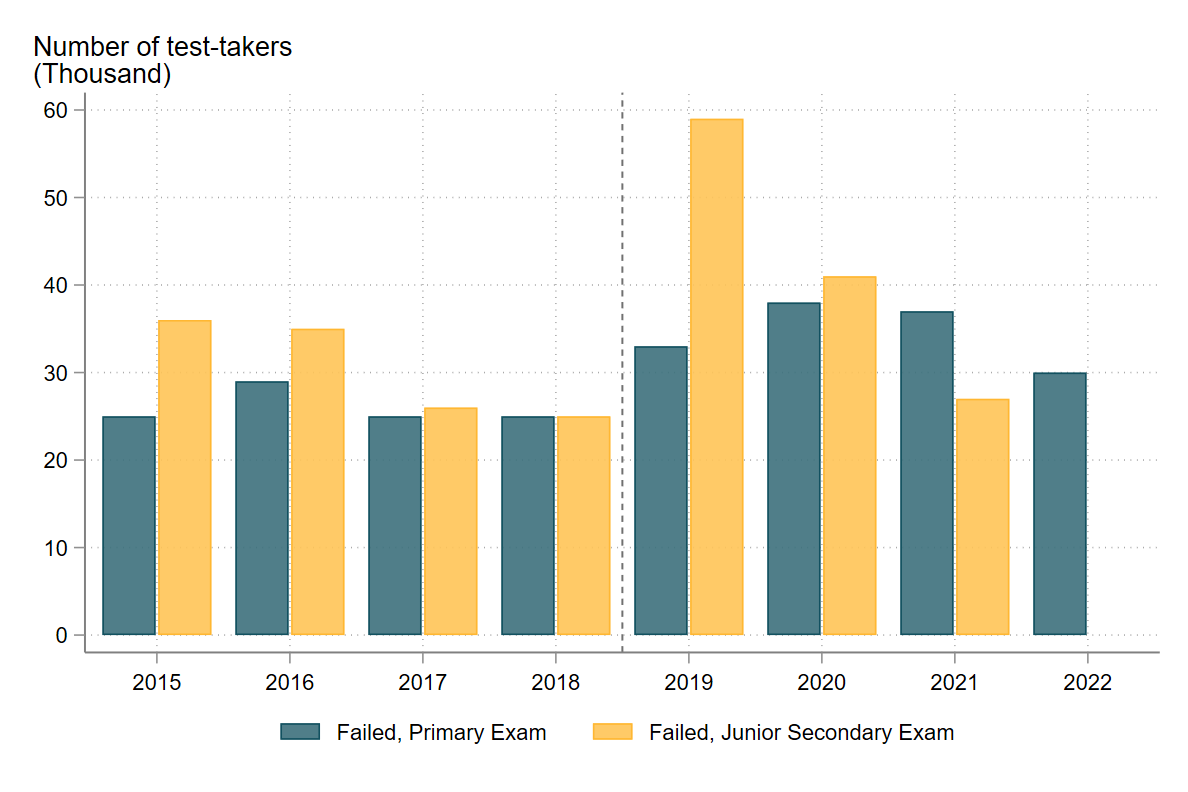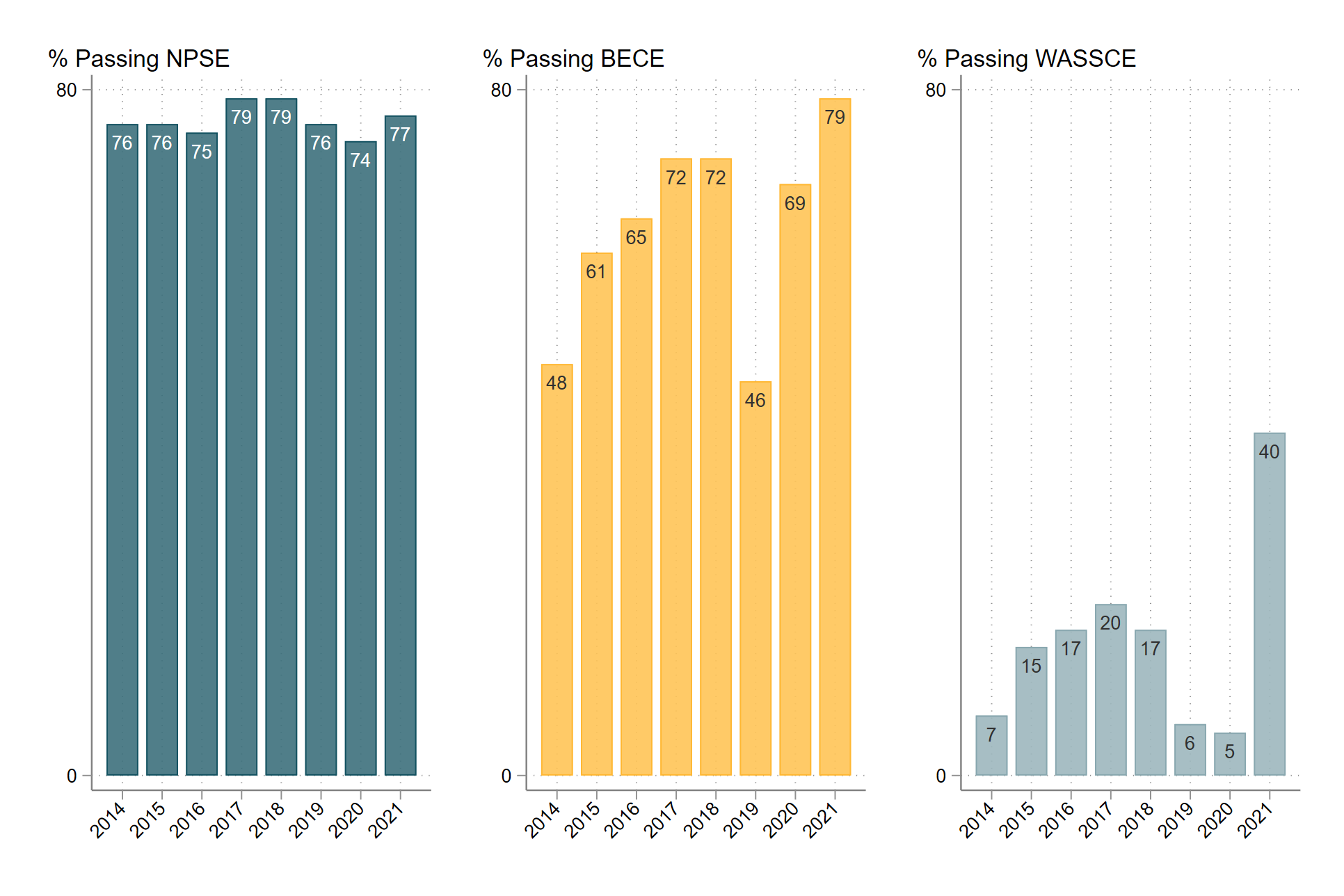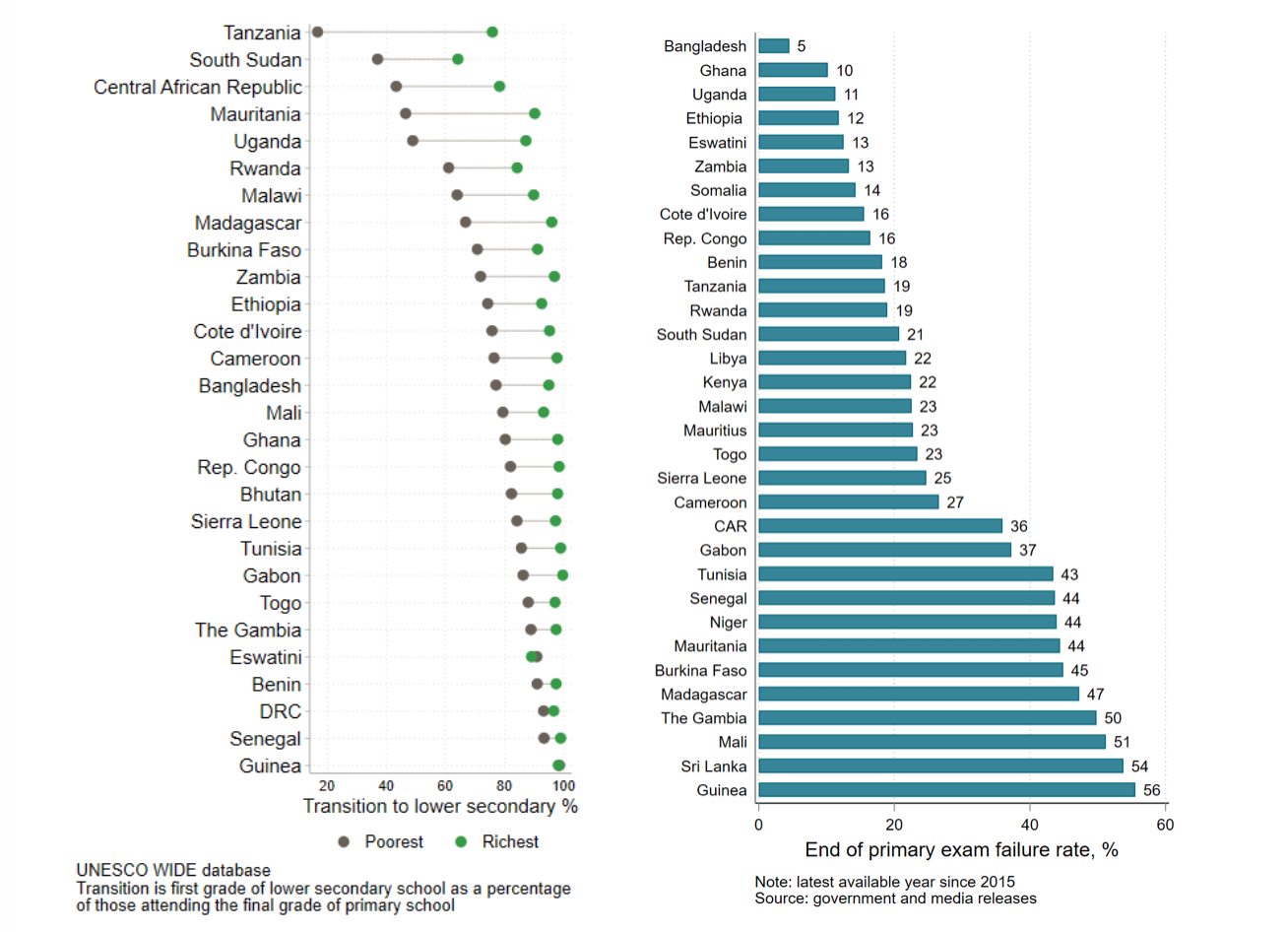Recommended
It’s precisely four years since Sierra Leone kicked off one of the most ambitious schooling expansions on record. Today, fee-free and ‘Radical Inclusion’ policies support marginalized groups, including pregnant girls and the poorest children, to participate in school. The government is throwing support behind its policy positions—and it’s quickly getting results.
Financing for the education sector is up. Fees and discriminatory regulations no longer bar access. Kids are coming back to school. Data already point to a distinctly pro-poor shift in grade completion. And more candidates are sitting and passing exams. But exams are also beginning to counteract progress.
Paradoxically, more children have been failed by high-stakes exams in the first four years of Free Quality School Education than in the four years before fees were abolished. As enrolment is rising rapidly among children from poorer households, so is the total number of exam failures, weakening the promise of Radical Inclusion. But examination and selection systems needn’t slow progress—they can be reshaped to align with the country’s bold inclusion agenda.
In this blog we spotlight Sierra Leone’s push for fee-free education for all and the impressive results it’s beginning to deliver. Then we look at the challenge that national exams are posing for the inclusion agenda, and for stakeholders who rely on results to track system performance. Finally we sketch out some options for how the country might shift its assessment and selection systems in ways that can propel it further towards Schooling For All.
Bold policies are delivering a lot more schooling, particularly for the poorest
Sierra Leone is on a path to Schooling For All that “is about creating an enabling and inclusive environment that eradicates stigma, harassment, intolerance and exclusion of any kind.” An Education Act guarantees nine years of fee-free education for all children and the most recent reforms seek to dismantle “all infrastructural and systemic policy and practice impediments that limit learning for any child”.
School enrolments are surging, up from 2.0 to 3.1 million students from 2018 to 2021. Increases are largest in primary grades, but Junior Secondary and Senior Secondary enrolments also show a substantial uptick. From school censuses it’s unclear exactly where these students come from. But anecdotally, the new policies have created opportunities for lower-income students, who were previously unable to pay fees, to re-enrol, or join school for the first time.
Recent household survey data on school completion support this pro-poor interpretation (Figure 1). While there is little movement among middle-income and richer households, groups in the bottom half of the income distribution fare a lot better in 2019 than in 2017. The latest series does come from mid-2019, so it’s likely capturing changes that were in motion pre-reform. But with or without that caveat we’re witnessing a highly progressive shift in completion at every level of education.
Figure 1: A progressive shift in completion rates at every level of education

Source: Sierra Leone MICS 2017 and Sierra Leone DHS 2019. Note: Shown for SDG Indicator 4.1.2, i.e. the percentage of a cohort of children or young people aged 3-5 years above the intended age for the last grade of each level of education who have completed that grade. Also reproduced via UNESCO UIS as part of their SDG 4.1.2 monitoring.
The rapid pace of change is quickly turning attention towards institutional barriers to universal participation, including exams. Shortly before the reforms, almost half of those not attending school in Sierra Leone said they were not doing so due to lack of money. And another 10 to 15 percent were not attending based on marriage, pregnancy or disability. But get rid of those situational reasons—as fee-free and inclusion policies are doing—and the institutional barriers for not attending come into focus. Key among these are exams and test-based selection systems.
High-stakes exams are eating into progress and beginning to drive exclusion
As enrolments surge, record numbers of children are registering for and passing school exams. But at the same time, more children have been failed by high-stakes exams in the first four years of Free Quality School Education than in the four years before the fee-abolition (Figure 2). The government has discussed how education is evolving from a system of restriction and privilege, but is “still haunted by vestiges of elitism from the past”. Exam-based filtering at the end of primary school is one of these ghosts.
The National Primary School Examination is taken after six years of school and serves as the gateway to completing basic education. In principle, every child could pass this test. But in practice, raw scores are standardized and a cut-score is set by the government that results in pretty much 1 in 5 candidates failing each year (Figure 3).
Children do have the option to resit tests—many do—but first generation learners or otherwise marginalized groups with lower average achievement, are more likely to fail and exit before entering the next level. Success and failure can be highly concentrated too: in 2021 there were 867 schools with 100 percent pass rate, but 196 schools where not a single candidate passed.
Figure 2: Many more children have been failed by high-stakes exams since abolishing fees

Source: collated from annual reports on examinations and 2016-2021 Basic Education Transition Examination Analysis, Ministry of Basic and Senior Secondary Education. Results for 2022 Junior Secondary Exam are not yet released.
The government of Sierra Leone has questioned the purpose of a pass/fail exam after six years, when nine years of fee-free education are guaranteed for all children. National guidelines go on to criticize primary and secondary examinations because:
- “[of] their power to select some learners for the next stage, whilst condemning the rest as failures with little prospects for advancing in life.”
- “[of] their backwash effects on school-based learning assessment…[leaving teachers] obsessed with preparations for [primary] and [secondary exams]”; and
- “Assessment tends to focus on cognitive mastery, especially at the recall level, at the expense of other skills and competencies.”
Current exams may not serve policymakers or other stakeholders very well either.
For each Grade 6 cohort, exam scores determine admissions into secondary schools and results are useful in identifying disparities among groups. Yet with average subject scores differing by less than 1 point there is little information to guide which subjects or skills need the most support. And without a statistical link across cohorts, stakeholders will struggle to evaluate how large reforms are influencing quality (Figure 3).
Later, each Grade 12 cohort will sit the WASSCE, with research suggesting low quality test items and large variations in test difficulty from one year to the next. The big question for the WASSCE is how to interpret swings in pass rates (i.e. the minimum grades required to enter a degree program) as they fall from 20 percent in 2017 to 5 percent in 2020, before jumping to 40 percent in 2021. If the exam is not measuring the same standard each year then the government is paying for tests which (i) arbitrarily exclude children in some years; and (ii) provide little helpful information to monitor progress for the enormous outlay on education. On an operational level, officials have also aired their dissatisfaction around restrictive data access and the paywall facing students before they can view their results.
Figure 3: Large swings in Sierra Leone’s high-stakes exams can be hard to explain and may be of little use for policy making

Source: collated from annual reports on examinations and 2016-2021 Basic Education Transition Examination Analysis, Ministry of Basic and Senior Secondary Education. For the purposes of this chart, a ‘Pass’ in the WASSCE is equivalent to achieving a Credit score (A1-C6), in at least 5 subjects, as is the national benchmark for entry to a degree course in Sierra Leone.
Tackling the negative effects of test-based selection
Broadly, there may be two paths for overcoming the negative influences of test-based selection in the context of Sierra Leone’s ambitious inclusion agenda.
The direct path: overhaul the assessment and selection system. Accept that Sierra Leone will have to ration access at secondary levels for a while longer, but turn to the evidence on how to select students into places in a way that boosts inclusion. One approach could be a ’top percent’ rule that guarantees selection to anyone in the top X percent of their primary school class. No, this won’t increase total admission rates, but it can lower educational inequalities while secondary school places are added. And well-designed affirmative actions can encourage future cohorts of marginalized students to gain more years of schooling too. Alternatively, where there are more students than places, it may just be fairer to use lotteries to select among candidates, as several countries have shown how to do.
The indirect path: rapidly expand spaces at secondary levels, get rid of the need for selection, and meet the guarantee of nine years of basic education for all. In its simplest form this means more school buildings, more teachers, school resources and so on. But it may instead call for more creative ways of recruiting and deploying specialist teachers, or adjusting the school day or term-time calendar to fit more students into the same infrastructure (e.g. as in Ghana’s Free Senior High School reform).
Much of the groundwork is in place, with Sierra Leone’s education data already supporting planning tools, a school infrastructure policy and even an app for public consumption. Indeed several selection approaches could be piloted within these data systems, which link examination and school census records. Then careful monitoring and research of the effects for different student groups is needed, including the knock-on impacts to future cohorts.
Sierra Leone is rapidly delivering its transformational agenda of Free Quality School Education and Radical Inclusion. As enrolments rise, exam and selection reform may be the next progressive, and accessible, institutional lever to advancing Radical Inclusion and providing Schooling For All in Sierra Leone.
With thanks to Radhika Nagesh, Paul Atherton, Dr. Albert Dupigny, Mathias Esmann, Ayesha Khan, Justin Sandefur and Susannah Hares for helpful comments. All errors are our own.
Disclaimer
CGD blog posts reflect the views of the authors, drawing on prior research and experience in their areas of expertise. CGD is a nonpartisan, independent organization and does not take institutional positions.
Image credit for social media/web: Adobe Stock






